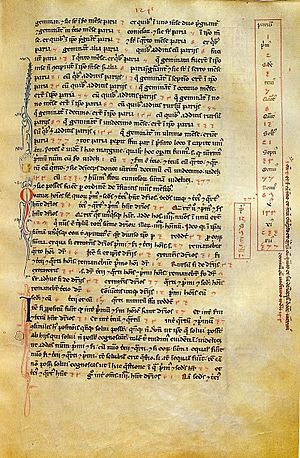Fibonacci facts for kids
Quick facts for kids
Fibonacci
|
|
|---|---|

Statue of Fibonacci (1863) by Giovanni Paganucci in the Camposanto di Pisa
|
|
| Born | c. 1170 Pisa, Republic of Pisa
|
| Died | c. 1250 (aged 79–80) Pisa, Republic of Pisa
|
| Other names | Leonardo Fibonacci, Leonardo Bonacci, Leonardo Pisano |
| Occupation | Mathematician |
| Known for |
|
| Parent(s) | Guglielmo "Bonacci" (father) |
Fibonacci (born around 1170 – died around 1240–50) was a famous Italian mathematician. He is also known as Leonardo Bonacci or Leonardo of Pisa. Many people consider him the most talented Western mathematician of the Middle Ages.
The name "Fibonacci" was given to him later, in 1838. It means "son of Bonacci." However, some records from 1506 already called him "Lionardo Fibonacci."
Fibonacci helped make the Hindu–Arabic numeral system popular in Europe. This is the number system we use today, with digits 0-9. He did this mainly through his book, Liber Abaci (which means Book of Calculation), written in 1202. He also introduced Europe to the special set of numbers called Fibonacci numbers. He used these numbers as an example in his book.
Contents
Fibonacci's Life Story
Fibonacci was born around 1170 in Pisa, Italy. His father, Guglielmo, was a merchant and customs official. Guglielmo worked at a trading post in Bugia, Algeria.
Fibonacci traveled with his father when he was a young boy. It was in Bugia that he learned about the Hindu–Arabic numeral system. This system was very different from the Roman numerals used in Europe at the time.
Traveling and Learning Numbers
Fibonacci traveled a lot around the Mediterranean Sea. He met many merchants and learned about their different ways of doing math. He quickly saw how useful the Hindu-Arabic system was.
Unlike Roman numerals, the Hindu-Arabic system uses a place-value system. This means the position of a digit changes its value (like in 123, the '1' means 100, not just 1). This made calculations much easier and faster.
In 1202, he finished his important book, Liber Abaci. This book helped spread the use of Hindu–Arabic numerals across Europe.
Working for the Emperor
Fibonacci was a special guest of Emperor Frederick II. The Emperor loved mathematics and science.
In 1240, the city of Pisa honored Fibonacci. They gave him a salary because he had helped the city. He was an advisor on accounting and taught citizens about numbers.
Fibonacci is believed to have died in Pisa sometime between 1240 and 1250.
About Liber Abaci

In his book Liber Abaci (published in 1202), Fibonacci introduced the "method of the Indians." This is what we now call the Hindu–Arabic numeral system. The book explained how to use the digits 0–9 and how place value works.
Practical Uses of Numbers
The book showed how useful the new Hindu-Arabic number system was in real life. It explained how to use these numbers for things like:
- Keeping track of money in business (bookkeeping)
- Changing different weights and measures
- Calculating interest on loans
- Exchanging different types of money
This book was very popular throughout educated Europe. It greatly changed how people thought about numbers. The original book from 1202 is not known to exist today.
Improving Business Calculations
A copy of the book from 1228 first explains the Hindu-Arabic numeral system. It also compares it to other systems, like Roman numerals. It showed how to change numbers from other systems into Hindu-Arabic ones.
Replacing Roman numerals and old calculation methods with the Hindu-Arabic system was a big step forward. It made business math easier and quicker. This helped banking and accounting grow in Europe.
The second part of the book explains how to use Hindu-Arabic numerals in business. For example, it showed how to convert different currencies. It also explained how to calculate profit and interest. These skills were very important for the growing banking world. The book also talked about irrational numbers and prime numbers.
The Fibonacci Sequence
In Liber Abaci, Fibonacci presented a problem about how a population of rabbits would grow. The answer to this problem, generation by generation, created a series of numbers. These numbers later became known as Fibonacci numbers.
Fibonacci's book has the first known description of this sequence outside of India. However, Indian mathematicians had described this same sequence much earlier, as far back as the sixth century.
How the Sequence Works
In the Fibonacci sequence, each number is found by adding the two numbers before it. Fibonacci started his sequence with 1, 2, 3, ... . Today, the sequence usually starts with 0, 1, 1, 2, 3, ... .
He calculated the sequence up to the 13th number, which is 233. Another copy of his book goes one step further, to 377. Fibonacci did not talk about the golden ratio. This is a special number related to the ratio of consecutive numbers in the sequence.
Fibonacci's Lasting Impact
In the 1800s, a statue of Fibonacci was placed in Pisa. Today, you can find it in the western gallery of the Camposanto Monumentale. This is a historic cemetery in the Piazza dei Miracoli.
Many mathematical ideas are named after Fibonacci. This is because they are connected to the Fibonacci numbers. Some examples include the Brahmagupta–Fibonacci identity and the Fibonacci search technique. Outside of math, there's even an asteroid called 6765 Fibonacci and a music band named The Fibonaccis!
See also
 In Spanish: Leonardo de Pisa para niños
In Spanish: Leonardo de Pisa para niños

